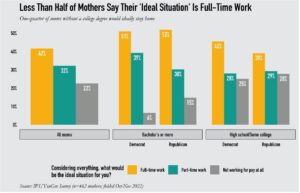During the COVID-19 pandemic, women dropped out of the workforce in large numbers to care for children at home.
Conservatives were split on how to approach this trend. One wing of conservatism suggested that all the stops be pulled out so that mothers could rejoin the workforce as quickly as possible in order to boost GDP. In May 2021, the official Twitter account of the Republican Party announced: “1.5 million U.S. mothers have fallen out of the workforce, and many are staying home to take care of their children because schools have not re-opened. Biden is proving to be a detriment to getting mothers back to work.” By contrast, in an interview during the same year, social conservative journalist Sohrab Ahmari contended that “a huge component of being able to live an ordinary life of virtue means that it should be enough and possible to raise a family on one income in this country.” A divide emerged between conservatives who prioritized economic growth and those who prioritized supporting one-income families.
This split is misguided. Homemakers are central to the economic, social, and political functioning of the nation. Homemakers, to be clear, can be both women and men, although the vast majority are female, and so this essay primarily refers to homemaker moms. These women play a vital role in childcare and eldercare. They also are critical to America’s social cohesion.
The current dichotomy between “pro-GDP” Republicans who want mothers in the workforce and “pro-family” Republicans who want to support families with a homemaker parent stems from a failure to understand the reality of what homemakers do. Far from being a mere vestige of the past, America’s twenty-first-century homemakers are a vital and vibrant part of America’s growth and prosperity. Support for homemakers is not just good politics; it’s good economics, too. The entire spectrum of conservative politicians and thinkers should prioritize government support for homemakers.
Far from being a mere vestige of the past, America’s twenty-first-century homemakers are a vital and vibrant part of America’s growth and prosperity.
Start your day with Public Discourse
Sign up and get our daily essays sent straight to your inbox.The History of Homemaking and the GDP
To recognize why homemakers are often not given their due by conservatives who focus on America’s GDP, we need to start with the origins of the metric itself. The GDP is intended to be a “comprehensive measure of U.S. economic activity.” In 1934, Simon Kuznets presented Congress with the research that would become today’s GDP calculation. However, he cautioned that it omitted the “services of housewives and other members of the family.” This omission had significant and lasting impacts on how American policymakers view homemaking. There is an aphorism in business that “what gets measured gets managed,” with the corollary that “what gets measured, matters.” The value of homemaking was not measured in the GDP, and so—in the eyes of many economists and politicians—it did not matter.
This is profoundly incorrect. While homemaking is not measured in the traditional GDP metric, it contributes a great deal to the national economy. As Harvard Professor of Economics Claudia Goldin points out in her book Career and Family, estimates of “the value of unpaid care work in the entire economy” would amount to the “staggering” value of “a full 20 percent of GNP.” (The U.S. Bureau of Economic Analysis defines GNP, or Gross National Product, as: “The market value of goods and services produced by labor and property supplied by US residents, regardless of where they are located. It was used as the primary measure of U.S. production prior to 1991, when it was replaced by gross domestic product (GDP).”) Goldin’s conclusion is drawn from research by the U.S. Bureau of Economic Analysis (“BEA”), which recognizes that the GDP is an incomplete metric, specifically because it does not include the value of household labor. Thus, the BEA has published a series of papers aimed at calculating the impact of household work on the national economy.
In addition to observing that household work—if included—would raise the nominal level of the GDP significantly, this paper series also provides an important adjustment to GDP (as currently calculated) regarding the impact of women leaving the home to enter the workforce in the 1960s and 1970s. It notes that as women began engaging in more paid work, they engaged in less household production, and so GDP growth should be revised downward. As the BEA has explained: “Including the household sector in GDP slows the growth rate of output. From 1965 to 2017, the average annual growth rate of nominal GDP was 6.5 percent. When household production is included, this growth rate drops to 6.3 percent.”
The value of homemaking was not measured in the GDP and so—in the eyes of many economists and politicians—it did not matter.
Taking the value of homemaking into account when we consider the overall national economy also helps eliminate various strange distortions caused by the way the GDP is currently calculated. As Oren Cass observed in The Once and Future Worker, under the current system: “two mothers who would prefer to take care of their own children would create GDP growth by hiring each other as nannies instead, because unpaid work for one’s own family goes uncounted but paid work for someone else’s represents new economic activity.” Or, as economist Marc Goldwein explains, a woman taking care of her own children is engaging in activity that might be worth $30,000 annually. If she goes out and gets a job where she is paid $40,000, “GDP is $40k higher even though actually” only $10k of value has been created. This simplistic view of GDP growth should be rejected. A more balanced approach would recognize that GDP is a useful, but very incomplete metric—and there is significant value to homemaking that should be considered when we think about the nation’s economic health.
The Value of Homemakers
Although largely unrecognized, homemakers are a vital part of the framework of American society. They play a critical role in the smooth functioning of our society in ways too numerous to tally here. I’ll focus on just three: childcare, eldercare, and social cohesion. In each of these areas, women and men who consider the home to be their primary vocation provide significant services to their families, communities, and the nation as a whole.
First, childcare. During the COVID-19 pandemic, it became crystal clear that childcare—rather than being solely a personal matter—is also a business and economic issue. As the Harvard Business Review put it:
When the Covid-19 pandemic removed the safety net of schooling and employee-paid childcare for working families, the damage was cataclysmic. Without a stable form of childcare as part of the business infrastructure, the world stopped working for the vast majority of working parents around the world. One third of the U.S. workforce, or an estimated 50 million workers, has a child under 14 in their household.
Left-of-center policymakers recognized this fact, but used it to advocate greater government support for public school wrap-around care, universal pre-kindergarten, and universal daycare. President Biden’s failed American Families Plan, for example, called for $200 billion in spending on universal pre-K, and $225 billion on government-subsidized daycare, on the grounds that “our nation is strongest when everyone has the opportunity to join the workforce and contribute to the economy.” Similarly, on the municipal level, New York City lawmakers have called for greater government-funded daycare on the grounds that “childcare is essential for families to ensure their children receive quality care and working parents can succeed in the workforce” (emphasis added).
Quality childcare for America’s babies and toddlers is unquestionably important. However, rather than prioritizing government-provided universal preschool and daycare, conservative politicians should prioritize supporting homemakers. Those who care for their young children at home play a critical role in America’s prosperity, but without the massive government bureaucracy and spending inherent in universal daycare and preschool. A mother at home knows her own children’s specific needs, can care for them according to her own family values and priorities—and she can do so without the many layers of regulation inherent in caring for little kids through government-sponsored childcare.
To take just one example, a daycare seeking reimbursement from the federal government for children’s meals must parse out the many regulatory requirements to be followed. The U.S. Department of Agriculture provides a 82-page handbook to assist in this task, covering topics such as “Approved Meal Types,” “Nutrition Education,” “Water Availability,” “State Agency Monitoring Requirements,” and “Computing Reimbursement.” Complying with these requirements necessitates special training and careful record keeping, and it involves the risk that daycares that fail to check all the right boxes will not be reimbursed. A mom, by contrast, just has to put lunch on the table.
A mother at home knows her own children’s specific needs, can care for them according to her own family values and priorities—and she can do so without the many layers of regulation inherent in caring for little kids through government-sponsored childcare.
Caring for the Elderly
Second, in addition to caring for children, homemakers play a vital role in caring for the elderly. The U.S. government’s largest category of spending is on seniors. Nineteen percent of the federal budget is spent on Social Security, and a further 12 percent is spent on Medicare. In total, a whopping 31 percent of the federal government’s expenditures is dedicated to funding streams primarily meant for those over the age of 65. (Not all Medicare and Social Security expenses are used solely for eldercare, because in certain cases people with significant disabilities or illnesses can use those programs. Nevertheless, the vast majority of spending in both programs is on the elderly.)
It is often unappreciated, however, how much higher those expenditures would be were it not for the unpaid family members who take care of America’s elderly. The AARP estimates that one in five Americans is an unpaid caregiver, spending an average of 24 hours per week on caregiving tasks. Most are women, and most are caring for their elderly parents. They provide an average of five years of unpaid care, very often at significant financial cost to themselves. Many women drop out of the workforce to take care of older parents, and even those that remain in the workforce often have to make career changes resulting in significant financial sacrifice.
In 2016, the Atlantic interviewed two highly educated professional women with well-paying jobs—who both, in spite of their advantages, felt the career impacts of caring for a declining older relative. One woman, a self-employed consultant, had a mother diagnosed with Alzheimer’s. She estimated that she spent 20 to 30 hours per week caring for her mother, which required her to drop clients. Another woman had to downshift from her fast-paced job due to her caregiving responsibilities.
Miriam Diwan was on the fast track at a big private equity firm when her mother was diagnosed with a malignant brain tumor. Management, Diwan says, was supportive. “My managing director kept telling me my mom was my number one priority,” she says. That helped alleviate some short-term pressure at work, but ultimately Diwan resigned from the firm. She and her mother relocated to Los Angeles to be near doctors at UCLA, and Diwan chose to move to a company with a more flexible schedule than her first firm afforded. “It’s really tough when it’s up or out,” says Miriam. “In a high-stress career you have to make the career your life. But to be the primary caregiver takes up a lot of time.”
Those who dial back their careers or leave the workforce entirely to take care of older relatives play a key role in America’s stability. In 2021, the AARP valued their care at approximately $600 billion annually. To put this in perspective, the United States spends around $755 billion on Medicare each year. In other words, without the contributions of unpaid caregivers, U.S. spending on healthcare for seniors would increase significantly. Prioritizing support to homemakers who care for the elderly is not only the right thing to do—it is a smart economic decision for the federal government.
As America continues to gray, the country’s ability to care for the elderly will utterly founder without those who provide unpaid care to their parents and older relatives. Even in the status quo, elder care has been described by a researcher at one think tank as “a slow-moving train wreck.” Conservatives interested in achieving a balanced budget should make supporting homemakers who care for older relatives a top priority. When older Americans with serious health problems have no family members to take care of them, they almost inevitably require substantial government-funded care, including social workers, long-term care facilities, and other significant medical and professional caregiving expenses.
As America continues to gray, the country’s ability to care for the elderly will utterly founder without those who provide unpaid care to their parents and older relatives.
Social Cohesion
Third, homemakers play an essential role in the social cohesion that holds America together. As Richard Reeves, an economist at Brookings, points out: “Social solidarity is withering, as evidenced by the fading influence of mediating institutions like unions, churches, and social clubs.” This lack of social ties not only has mental and emotional impacts on isolated individuals—it also reduces America’s ability to come together as a united country. Reeves writes: “Dwindling participation in the community organizations that used to bridge social gaps means that Americans tend more and more to interact exclusively with people who are like themselves.”
We should recognize the role that homemakers have played in creating the tight social bonds that have held America together since her founding. As Emma Green noted in a 2016 Atlantic article: “Women have long formed collective organizations intended to improve American society.” Groups of homemakers were critical in supporting Continental soldiers during the Revolutionary War, in the abolitionist and suffragette movements, and in creating community safety nets for the elderly and poor in twentieth-century America. However, as Green points out, since women began participating in the labor market en masse in the 1970s, “this kind of civic engagement has dropped precipitously, . . . [and t]he most vulnerable members of society have lost their best allies—women—partly because those women are too busy working.”
As Yuval Levin eloquently observes in A Time to Build, American conservatives should seek to rebuild civil society in a way that prioritizes drawing people closer together through close-knit relationships, local civic institutions, and mutual dependence. Left-of-center thinkers often seek to solve social ills through expanding the welfare state, devoting significant federal expenditures and increased bureaucracy to distributing aid to the poor and marginalized. By contrast, as Levin points out, conservatives should seek to build a civil fabric composed of local institutions; because:
To participate in meaningful institutions at the level of the interpersonal—the civic and communal level, the level of the school, the church, and the union hall—is to understand ourselves as embedded in relationships of commitment, obligation, and responsibility.
Homemakers play a key role in forming this close-knit social fabric. Indeed, a special benefit of supporting homemakers is that they tend to form support networks with each other, providing flexible and adaptable mutual assistance, including caring for each other’s children during emergencies, dropping off home-cooked meals to new moms, organizing fundraising for families facing unexpected medical bills, providing “Moms Day Out Groups” that reduce postpartum depression, and more. As Leah Libresco Sargeant observes: “A neighborhood with a critical mass of [homemakers] is closer to being able to sustain what O. Carter Snead calls ‘the network of uncalculated giving and graceful receiving that must exist for any human being to survive and flourish.’ At any given moment, someone needs, and someone can give.”
The flexibility and adaptability provided by homemakers can never be matched by government institutions (even with their far greater resources). As Oren Cass writes, “Sending the kids across the street . . . is a far more efficient and cost-effective option for emergency childcare than anything the government or the market might provide.” This is not to say, of course, that homemakers can replace all aspects of the federal social safety net. However, conservative policymakers should ensure that the special role homemakers play in this area is supported.
All of the above should be obvious. Too often, however, the key role that homemakers play in America’s functioning is ignored or belittled. In 2017, Ben Young (then an Oxford student) gave a TedTalk titled “Why Have We Stigmatized and Marginalized the Stay-at-Home Mom?” Young found that when he did a Google search for the phrase “stay at home moms are,” the four most popular autocompletes were as follows:

Young notes that, when it comes to homemakers, “we have a flawed conception of value,” primarily because they do not fit current thinking about economic benefits and professional growth. It is normal to see public figures fête women who have achieved the height of success as lawyers, politicians, and business leaders. There are rarely public celebrations of women who do the difficult, full-time work of caring for their children and families.
As Erika Bachiochi writes in The Rights of Women, the work of the family is at the heart of society, but it is often not recognized as such. She observes: “The essential work of mothers and fathers in their homes is not taken seriously as ‘work,’ nor is the caregiving they do there understood as providing the necessary preconditions for our economic, political, and civil life together.” Conservatives should reject this view of homemakers as “lesser” than those who pursue professional goals outside the home, and rightly appreciate their role in America’s flourishing.
The Case for Government Support for Homemakers
Even conservatives focused primarily on GDP growth usually recognize a role for government spending on and attention to the preconditions and frameworks needed for economic development and social cohesion. As Senator Bill Cassidy pointed out in a 2021 Wall Street Journal article, conservatives should be in favor of government spending when needed to “improve economic efficiency and productivity, which would translate into higher gross domestic product and government revenue over time.” Responsible stewardship, Cassidy notes, involves making needed investments to provide for the next generation and to strengthen communities.
Homemakers should be viewed by conservatives as part of America’s economic and social framework, deserving of investment in the same way that America has invested in other structural goods and services. They raise children, care for the elderly, hold society together, and do numerous other important jobs that are essential to the smooth functioning of the country. Just as conservatives generally support investing in the interstate highway system and the electrical grid, they should also seek to support homemakers.
Homemakers raise children, care for the elderly, hold society together, and do numerous other important jobs that are essential to the smooth functioning of the country.
Supporting homemakers would also be tremendously politically popular, particularly among Republican voters. In a recent survey published by American Compass, over 60 percent of Republicans said it was a “big problem” that families face economic pressure to have two working parents. Similarly, a survey published in February by the Institute for Family Studies and the Ethics and Public Policy Center found that among Republican moms without a college diploma, only 39 percent said their ideal work arrangement was full-time employment.

Credit: Patrick Brown, “Five Pro-Family Priorities for the 118th Congress and Beyond”
Despite the claims of some critics, supporting homemakers is also fundamentally pro-women. Jill Filipovic, a columnist at CNN, wrote last year that public policy that incentivizes women to become homemakers is sexist, as it would
damage the financial prospects of women much more broadly, and further entrench the very things that make so many stay-at-home moms so miserable: the isolated nuclear family with the mother home with the kids all day; men who don’t do their fair share; and a society that pushes its collective care burdens off on individual women.
Conservative politicians and thinkers should reject this narrow, patronizing, and erroneous view of homemakers. Again, data clearly show that many American women see homemaking as a desired vocation, not an oppressive tool of the patriarchy. Indeed, for plenty of women and families, trying to manage two full-time careers and children is profoundly difficult and oppressive. A recent New Yorker article described the life of an anonymous working mom as follows:
I get up at 6 a.m., and I work until [my child] wakes up, then I do breakfast and get her ready, then the nanny comes, I work all day, I relieve the nanny, and then get back on my computer and work until midnight after my daughter goes to sleep. I do that every day. And it’s still not enough.
Conservative support for homemakers need not take the form of a “caregiving wage” or other direct payments to families with a homemaker. Such support should be crafted to reflect traditional conservative values of efficiency, avoidance of waste, and rightful suspicion of new entitlement programs. I have sketched out some possible policy proposal here and here. These include modifying Social Security payments to better support modern homemakers, and enabling employers to provide useful benefits to families with homemakers through targeted legislation, such as a “Family 401(k).” But, regardless of the specifics, pro-natalist and pro-business conservatives should find common ground on this issue.
It’s been a decade since Sheryl Sandberg sparked a national movement to Lean In, encouraging mothers to give their all to their jobs and demand a seat at the boardroom table. Whatever the merits of Ms. Sandberg’s book as motivation for self-improvement among career-driven women, it misses the fundamental role that homemakers play in society. It should be a no-brainer that when women lean out of the workforce to support their families, government should lean in to support those women. It’s time for conservative policymakers to make it a priority.













